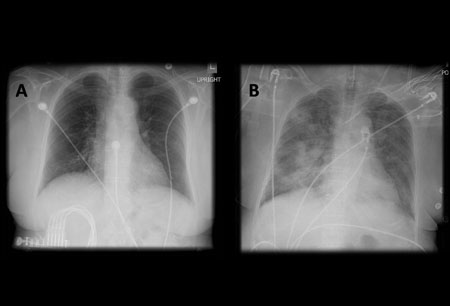Resumo
Definição
História e exame físico
Principais fatores diagnósticos
- presença de fatores de risco
- tosse crônica ou aguda
- febre
- dispneia
- sibilância
- estertores
Outros fatores diagnósticos
- Laringoespasmo
Fatores de risco
- nível de consciência reduzido (escore na escala de coma de Glasgow <9)
- doença mais grave
- anestesia geral
- idade >70 anos
- sexo masculino
- trauma cranioencefálico
- doença cerebrovascular
- tubo endotraqueal ou de traqueostomia
- disfagia
- dificuldades nas vias aéreas
- refeição de bário
- doença do refluxo gastroesofágico
- tubos de alimentação
- posição supina
- retardo do esvaziamento gástrico
- obesidade
- medicamentos que reduzem o tônus dos esfíncteres esofágicos
Investigações diagnósticas
Primeiras investigações a serem solicitadas
- radiografia torácica
Investigações a serem consideradas
- tomografia computadorizada (TC) do tórax
- broncoscopia com lavagem broncoalveolar
- Hemograma completo
- gasometria arterial
- hemocultura
- toracocentese
Algoritmo de tratamento
pneumonite causada por aspiração de conteúdo gástrico
pneumonite devida à aspiração de bário
Colaboradores
Autores
Augustine Lee, MD
Professor of Medicine
Division of Pulmonary and Critical Care Medicine
Mayo Clinic Florida
Jacksonville
FL
Declarações
AL declares that he has no competing interests.
Spencer Deleveaux, MBBS
Fellow
Division of Pulmonary and Critical Care Medicine
Mayo Clinic Florida
Jacksonville
FL
Declarações
SD declares that he has no competing interests.
Agradecimentos
Dr Augustine Lee and Dr Spencer Deleveaux would like to gratefully acknowledge Dr Madison Macht, Dr Kamran Mahmood, Dr Scott Shofer, Dr Septimiu Murgu, and Dr Henri Colt, previous contributors to this topic.
Declarações
MM, KM, SS, SM, and HC declare they have no competing interests.
Revisores
Andrew Parfitt, MBBS, FFAEM
Clinical Director
Acute Medicine
Associate Medical Director
Consultant Emergency Medicine
Guy's and St Thomas' NHS Foundation Trust
Clinical Lead and Consultant
Accident and Emergency Medicine
St Thomas' Hospital
London
UK
Declarações
AP declares that he has no competing interests.
Momen M. Wahidi, MD, MBA
Director
Interventional Pulmonology
Division of Pulmonary, Allergy, and Critical Care Medicine
Assistant Professor of Medicine
Duke University Medical Center
Durham
NC
Declarações
MMW declares that he has no competing interests.
Referências
Principais artigos
Marik PE. Aspiration pneumonitis and aspiration pneumonia. N Engl J Med. 2001 Mar 1;344(9):665-71. Resumo
Smith Hammond CA, Goldstein LB. Cough and aspiration of food and liquids due to oral-pharyngeal dysphagia: ACCP evidence-based clinical practice guidelines. Chest. 2006 Jan;129(1 suppl):154S-68S.Texto completo Resumo
American Society of Anesthesiologists. Practice guidelines for preoperative fasting and the use of pharmacologic agents to reduce the risk of pulmonary aspiration: application to healthy patients undergoing elective procedures - an updated report by the American Society of Anesthesiologists task force on preoperative fasting and the use of pharmacologic agents to reduce the risk of pulmonary aspiration. Anesthesiology. 2017 Mar;126(3):376-93.Texto completo Resumo
Smith I, Kranke P, Murat I, et al. Perioperative fasting in adults and children: guidelines from the European Society of Anaesthesiology. Eur J Anaesthesiol. 2011 Aug;28(8):556-69.Texto completo Resumo
Artigos de referência
Uma lista completa das fontes referenciadas neste tópico está disponível para os usuários com acesso total ao BMJ Best Practice.

Diagnósticos diferenciais
- Síndrome do desconforto respiratório agudo
- Exacerbação da asma
- Fibrose cística com exacerbação
Mais Diagnósticos diferenciaisDiretrizes
- ACR appropriateness criteria: dysphagia
Mais DiretrizesConectar-se ou assinar para acessar todo o BMJ Best Practice
O uso deste conteúdo está sujeito ao nosso aviso legal